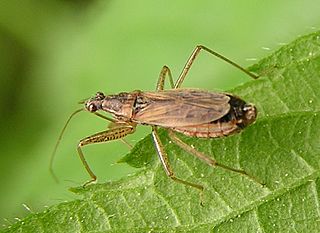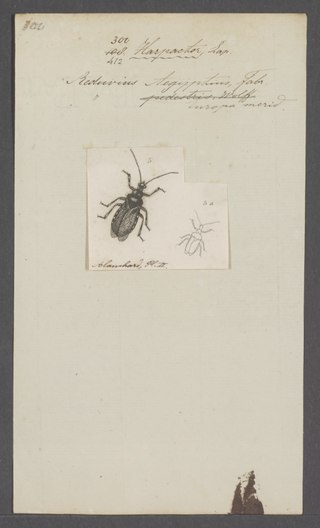
Pentatomidae is a family of insects belonging to the order Hemiptera, generally called shield bugs or stink bugs. Pentatomidae is the largest family in the superfamily Pentatomoidea, and contains around 900 genera and over 4700 species. As hemipterans, the pentatomids have piercing sucking mouthparts, and most are phytophagous, including several species which are severe pests on agricultural crops. However, some species, particularly in the subfamily Asopinae, are predatory and may be considered beneficial.

Coreidae is a large family of predominantly sap-sucking insects in the Hemipteran suborder Heteroptera. The name "Coreidae" derives from the genus Coreus, which derives from the Ancient Greek κόρις (kóris) meaning bedbug.

The insect family Nabidae contains the damsel bugs. There are over 500 species in 20 genera. They are soft-bodied, elongate, winged terrestrial predators. Many damsel bugs catch and hold prey with their forelegs, similar to mantids. They are considered helpful species in agriculture because of their predation on many types of crop pests.

The Cimicomorpha are an infraorder of insects in the order Hemiptera, the true bugs. The rostrum and other morphology of all members apparently is adapted to feeding on animals as their prey or hosts. Members include bed bugs, bat bugs, assassin bugs, and pirate bugs.

Alydidae, commonly known as broad-headed bugs, is a family of true bugs very similar to the closely related Coreidae. There are at least 60 genera and 300 species altogether. Distributed in the temperate and warmer regions of the Earth, most are tropical and subtropical animals; for example Europe has a mere 10 species, and only 2 of these occur outside the Mediterranean region.

The Harpactorinae are a large subfamily of the Reduviidae. About 300 genera and 2,000 species worldwide have been described. Some of the species of the genera Zelus, Pselliopus, Sinea, and Apiomerus are of interest as biological pest control agents.

Harpactorini is a tribe of the Harpactorinae. This group is the most diverse of the entire assassin bug family, with 51 genera recognized in the Neotropical Region and 289 genera and 2003 species overall.

Harpactor is a genus of assassin bug family (Reduviidae), in the subfamily Harpactorinae.

Anisoscelini is a tribe of leaf-footed bugs in the family Coreidae. It was formerly spelled Anisoscelidini, but the tribal name spelling was incorrectly formed.

The Stenopodainae are a subfamily of Reduviidae. Many species of this subfamily are endemic to tropical rainforests, and some smear their fore legs with sticky, plant-derived resin, to aid in prey capture.

Stenodema is a genus of Palaearctic, Oriental and Nearctic plant bugs in the family Miridae and the tribe Stenodemini.

Tingini is a tribe of lace bugs in the family Tingidae. There are at least 250 genera and 2,400 described species in Tingini.

Podopinae, known as turtle bugs, are a subfamily of the insect family Pentatomidae. The type genus is Podops.

Chariesterus is a genus of leaf-footed bugs in the family Coreidae. There are about 12 described species in Chariesterus.

Pnirontis is a genus of assassin bugs in the family Reduviidae. There are more than 30 described species in Pnirontis.
Diaditus is a genus of assassin bugs in the family Reduviidae. There are about six described species in Diaditus.
Burtinus is a genus of broad-headed bugs in the family Alydidae. There are at least two described species in Burtinus.

Heza is a genus of assassin bugs in the family Reduviidae. There are more than 30 described species in Heza found in the Americas.

Spartocera is a genus of leaf-footed bugs in the family Coreidae. There are about 18 described species in Spartocera.

The Micrelytrinae are a subfamily of true bugs in the family Alydidae, based on the type genus Micrelytra Laporte, 1833. Genera are recorded from the Americas, Europe and Asia.


















